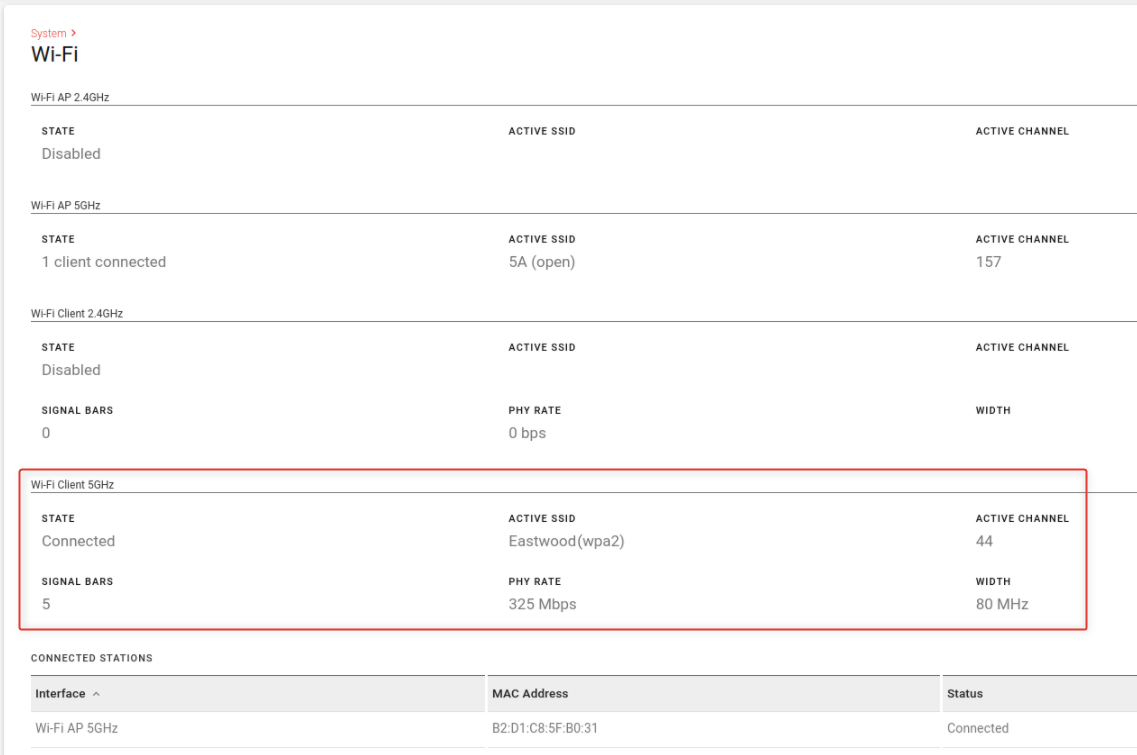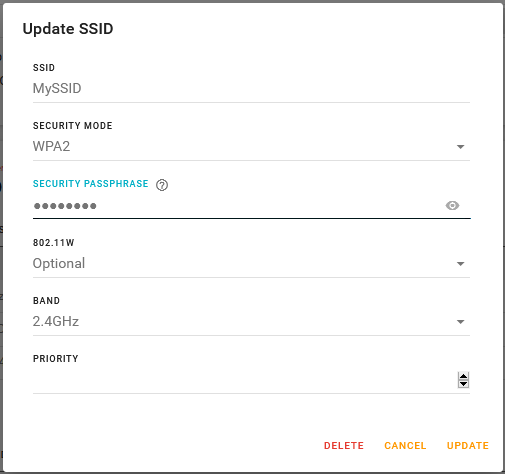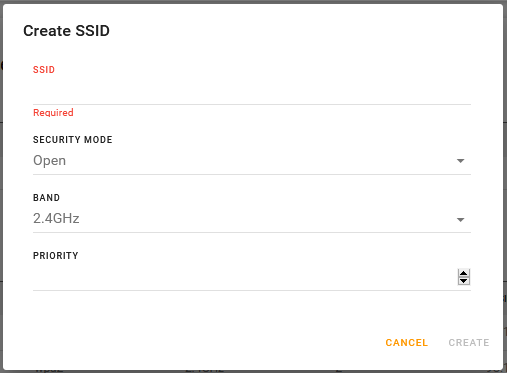Configuring Wi-Fi
This page shows you how to configure Wi-Fi for your AirLink router in Access Point mode and Client mode.
 Initializing Table Of Contents...
Initializing Table Of Contents...Wi-Fi Interfaces
On the XR80, the following Wi-Fi Interfaces are available:
- Wi-Fi AP 5GHz
- Wi-Fi AP 2.4 GHz
- Wi-Fi Client 5Ghz
- Wi-Fi Client 2.4GHz

Vehicle applications often require the router Wi-Fi to have Access Point and Client interfaces. The router will provide a Wi-Fi access point (using the cellular WAN) in the vehicle for laptops and other client devices. Client mode is required for when a service vehicle enters a depot, where the router can connect to another Wi-Fi network (instead of the cellular WAN). The in-vehicle devices can then take advantage of the increased bandwidth. Often, the router may need to upload video camera or vehicle data to the depot network.
Configuring a Wi-Fi Access Point
To configure the router as an Access Point, click ![]() at the end of the row of an Access Point interface (as shown above).
at the end of the row of an Access Point interface (as shown above).
Click Edit. The UPDATE CONFIGURE WI-FI RADIO menu appears.
- ENABLE the interface, and leave the MODE as Access Point.
Select the LAN SEGMENT that you’re going to use for this access point.
Tip: Click X to display the list of available LAN segments. LAN segments are configured under Bridges (Networking > Zones Settings > Bridges).
- Enter the access point’s SSID (a case-sensitive network name).
- Select the SECURITY MODE. For mode WPA2 or WPA2 Enterprise, 802.11w options appear. If required, select an option to enable 802.11w operation. The 802.11w standard uses Security Association Query Requests to ensure that clients are legitimate. Options are:
- Disabled
- Optional (default): 802.11w is used for clients that support it, while clients that do not support 802.11w will still connect to the router.
- Required: forces 802.11w operation; clients that do not support 802.11w will not connect.
For WPA3-only access points, Optional or Required must be selected.
- Enter a SECURITY PASSPHRASE of at least 8 characters.
- Enable AUTO CHANNEL to have the router select what channel to operate on. If you disable AUTO CHANNEL, you can select the desired channel from a list that appears below.
- PHYSICAL is the network standard to use. This is configured from the 5GHz or 2.4GHz Client mode settings.
- Select the MIMO (Multiple Input/Multiple Output) configuration for your installation to optimize throughput and signal quality. This is configured from the 5GHz or 2.4GHz Client mode settings.
- Select the WIDTH to configure the number of channels for maximum throughput. This is configured from the 5GHz or 2.4GHz Client mode settings.
- AUTO BEACON INTERVAL enables the router to send periodic messages (beacons) to advertise its availability. When AUTO BEACON INTERVAL is disabled, you can manually enter a beacon interval in milliseconds (100 ms is the default).
- DTIM PERIOD sets the number of beacons a client device can sleep through before waking up to check for messages. For example, if the DTIM Interval is set to 3, the client wakes up every third beacon. The higher the setting in the DTIM Interval field, the longer the client device can sleep, and the more battery power the client device can potentially save. However, high DTIM intervals can also reduce throughput to the client.
- With BROADCAST SSID enabled, the router makes SSID visible to client devices. When BROADCAST SSID disabled, the SSID is not shown to other devices, and the SSID and passphrase must be entered on the client for a client to connect.
- When CLIENT ISOLATION is disabled, clients can “see” each other, and potentially sniff traffic from each other. For passenger Wi-Fi applications, enable client isolation to enhance security. Disable if you have client applications on the same LAN segment that need to interact with each other.
- For MAX NUMBER OF CLIENTS, select up to 128 per interface. As a guideline, select a number slightly higher than the number of clients you expect to connect to the router simultaneously.
XR80 supports a total of 256 clients. Wi-Fi AP 5GHz and Wi-Fi AP 2.4GHz support up to 128 clients each.
A USE ADDITIONAL SSIDS option is below the WI-FI INTERFACES table. When USE ADDITIONAL SSIDS is enabled, a table appears from which you can select SSIDs, enable them and edit them. This allows you to use multiple SSIDs broadcasting on separate LAN segments and configured for different security protocols, if required.

Monitoring Access Point Mode Operation
On Status/Monitoring > Dashboard, the LAN dashboard shows you the Wi-Fi LAN interfaces and the LAN segments they use. A blue icon indicates the interface is enabled and operating.
Tip: Click a Wi-Fi LAN interface icon to go to the WI-FI INTERFACES configuration table and review your configuration.

Additionally, you can go to Status/Monitoring > System > Wi-Fi to view detailed Wi-Fi Access Point status, including the active channel and connected stations (clients).
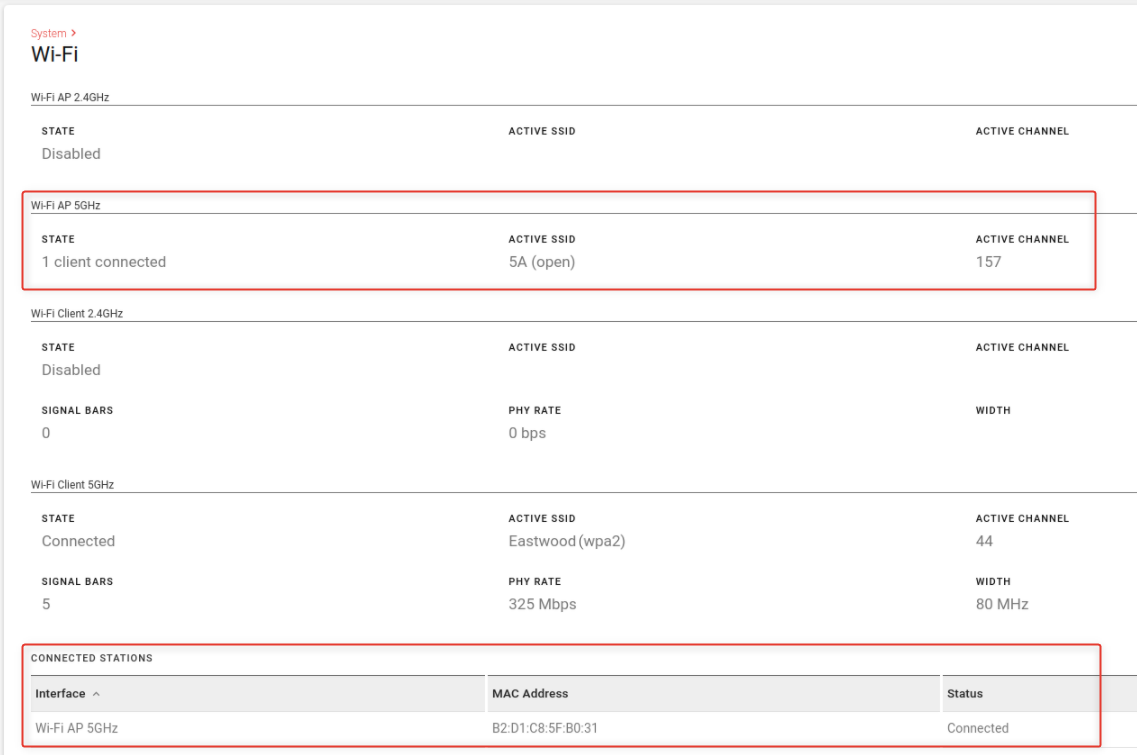
Configuring Wi-Fi Client Mode
You can create a Client Mode configuration by using a scanned SSID from the SSID Database, or by creating an SSID. The router will use the SSID for its WAN connection.
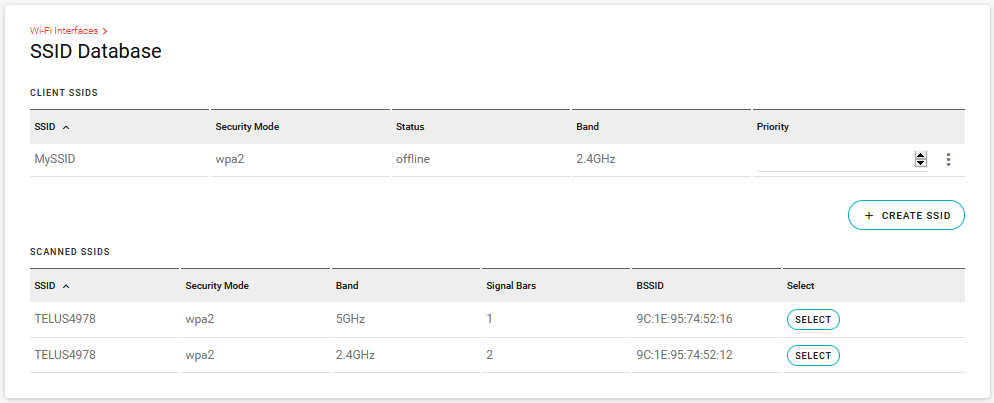
To use a scanned SSID:
- In the SCANNED SSIDS table, click SELECT to add the desired SSID to the CLIENT SSIDS table. You must then fully enable the new SSID by adding the SSID’s security passphrase.
- In the CLIENT SSIDS table, click edit
 for the desired Client SSID.
for the desired Client SSID. - In the Update SSID screen, add the security passphrase and assign a priority (optional).
- Click UPDATE.
After you configure the SSID with a passphrase, the Wi-Fi Client interface starts using it (if another SSID with a higher priority is not configured).
To create an SSID manually:
- Under the CLIENT SSIDS table, click CREATE SSID.
- Enter the SSID name.
- Select a SECURITY MODE. For mode WPA2 or WPA2 Enterprise, 802.11w options appear. If required, select an option to enable 802.11w operation. The 802.11w standard uses Security Association Query Requests to ensure that clients are legitimate. Options are:
- Disabled
- Optional (default): 802.11w will be used when connecting to access points that support it.
- Required: forces 802.11w operation; the router will not connect to access points unless they have 802.11w enabled. For WPA3-only access points, Optional or Required must be selected.
- Under BAND, select which radio to apply this SSID to.
- Select the PRIORITY. The smaller the value, the higher the priority. Leaving PRIORITY blank puts this SSID at the lowest priority.
- Click CREATE.
Additional Client mode configuration
You can complete the Client mode configuration in the WI-FI INTERFACES table.
To begin, click ![]() at the end of the row of an Client interface.
at the end of the row of an Client interface.
Most of the settings are described above in the Access Point section.
Settings specific to Client mode are:
SSID SELECTION
When you have multiple SSIDs configured, Sierra Wireless recommends leaving SSID SELECTION at the default Auto (Highest Priority) setting. The router will automatically search and connect to an SSID depending on priority. If priorities are identical, the router will use the closest SSID with the fastest estimated link speed. To configure the Wi-Fi client to use only a single, specific SSID, set SSID SELECTION to Manual and then choose the SSID you wish to connect to.
- PHYSICAL is the network standard to use. Note: This setting is also used for Access Point mode, but is only configurable in Client mode.
- 5GHz configuration: In general, select n/ac/ax, which uses the latest standard 11ax, and supports legacy compatibility for 11n and 11ac. n/ac is limited to 5GHz (no fallback to 2.4GHz), and is intended for equipment that requires specifying n/ac as the maximum standard.
- 2.4GHz configuration: In general, select b/g/n/ax, which also uses the latest standard 11ax, and supports legacy compatibility for 11b, 11g, and 11n. b and b/g/n are the other options available.
Select the MIMO (Multiple Input/Multiple Output) configuration for your installation to optimize throughput and signal quality. Note: This setting is also used for Access Point mode, but is only configurable in Client mode.
- 4x4 (default) enables all four antennas for sending and receiving traffic.
- 2x4 configures two antennas for sending, and four for receiving.
- 1x4 configures 1 antenna for sending, and four antennas for receiving. Select a non-default setting for an access point if you discovered problems with legacy equipment, have fewer than the maximum number of antennas connected, or to improve the router’s thermal performance.
The XR80 can have up to 5 Wi-Fi antennas connected. Antenna connectors 1 to 4 are used for MIMO. Connector 5 is used for scanning 5GHz in Client mode. At a minimum, the XR80 must have antennas connected to 1 and 5 to enable 5GHz operation. See the XR Series Hardware Guide for more information about antennas.
- Select the WIDTH to configure the number of channels for maximum throughput. Each channel uses 20 MHz of bandwidth, and you can use up to four channels (80 Mhz). Note: This setting is also used for Access Point mode, but is only configurable in Client mode.
- The TRANSMIT POWER LEVEL setting allows you to restrict transmit power to the Wi-Fi antenna(s). The actual transmit power attained depends on a number of factors including the regulatory domain and the wireless channel used. Generally, a higher transmit power setting results in greater Wi-Fi range for the clients. Transmit power is set to 100% by default, and can be adjusted for network conditions. If clients are connecting with many other clients nearby, high transmit power can cause interference and impede throughput across connected clients.
- SCAN INTERVAL, which sets how often the router scans for SSIDs when disconnected.
- BACKGROUND SCAN, which enables or disables the router scanning and connecting to higher priority SSIDs while already connected. Note: Not available for 5GHz Clients.
- BACKGROUND SCAN INTERVAL, which sets how often the router scans for other SSIDs when connected.
Monitoring Client Mode Operation
On Status/Monitoring > Dashboard, the WAN dashboard shows you the Wi-Fi WAN interfaces. A grey Wi-Fi icon indicates a disconnected interface. A blue Wi-Fi icon indicates an connected interface.
Tip: Click a Wi-Fi icon to go to the WI-FI INTERFACES configuration table and review your configuration.

Additionally, you can go to Status/Monitoring > System > Wi-Fi to view detailed Wi-Fi Client status, including bitrate and the active channel.
